Chilean Antarctic Territory
| Chilean Antarctic Territory Territorio Chileno Antártico | |||
|---|---|---|---|
| |||
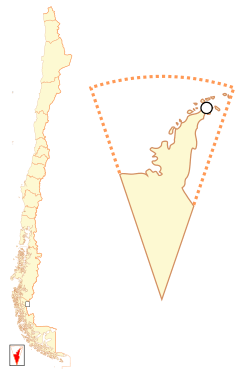 | |||
| Country |
| ||
| Region |
| ||
| Province | Antártica Chilena | ||
| Commune | Antártica | ||
| Claimed | November 6, 1940 | ||
| Government | |||
| • Intendant | Jorge Flies Añón | ||
| • Governor | Patricio Oyarzo Gáez | ||
| • Mayor | Pamela Tapia Villarroel | ||
| • INACH Director | José Retamales Espinoza | ||
| Area[1] | |||
| • Total | 1,250,257 km2 (482,727 sq mi) | ||
| Population (2012 Census)[1] | |||
| • Total | 115 | ||
| • Density | 9.2×10−5/km2 (0.00024/sq mi) | ||
| • Urban | 0 | ||
| • Rural | 115 | ||
| Sex[1] | |||
| • Men | 100 | ||
| • Women | 15 | ||
| Time zone | UTC-4 | ||
| Area code(s) | 56 + 61 | ||
| Capital | Villa Las Estrellas | ||
| Currency | Chilean Peso | ||
| Website | http://www.inach.cl/ (Spanish) | ||
The Chilean Antarctic Territory or Chilean Antarctica (Spanish: Territorio Chileno Antártico, Antártica Chilena) is the territory in Antarctica claimed by Chile. The Chilean Antarctic Territory ranges from 53°W to 90°W and from the South Pole to 60°S, partially overlapping the Argentine and British Antarctic claims. It is administered by the Cabo de Hornos municipality in the South American mainland.
The territory claimed by Chile covers the South Shetland Islands, Antarctic Peninsula, called "O'Higgins Land" ("Tierra de O'Higgins" in Spanish) in Chile, and adjacent islands, the Alexander Island, Charcot Island, and part of the Ellsworth Land, among others. It has an area of 257.6 km² 1250. Its boundaries are defined by Decree 1747, issued on November 6, 1940, and published on June 21, 1955, the Ministry of Foreign Affairs established:[2]
The Chilean Antarctica or Chilean Antarctic Territory is: all lands, islands, islets, reefs, glaciers (pack-ice), and others, known and unknown, and respective territorial waters, existing within the limits of the cap constituted by the meridians 53° longitude west of Greenwich and 90° longitude west of Greenwich.
Within Chilean territorial organization Antártica is the name of the commune that administers the territory. The comune of Antártica is managed by the municipality of Cabo de Hornos with seat in Puerto Williams and belongs to Antártica Chilena Province, which is part of Magallanes y la Antártica Chilena Region. The commune of Antártica was created on July 11, 1961, and was dependent on the Magallanes Province until 1975, when the Antártica Chilena Province was created, making it dependent administratively on Puerto Williams, the province capital.
Chilean territorial claims on Antarctica are mainly based on historical, legal and geographical considerations. The exercise of Chilean sovereignty over the Chilean Antarctic Territory is put into effect in all aspects that are not limited by the signing of the Antarctic Treaty of 1959. This treaty Antarctic activities devoted exclusively to peaceful purposes of the signatories and acceding countries, freezing territorial disputes and preventing the construction of new claims or the expansion of existing during their term
The Chilean Antarctic Territory corresponds geographically to areas UTC-4, UTC-5 and UTC-6. However, it applies in this entire regulation provided for the South American territory (UTC-3).
Chile currently has 11 active Antarctic bases: 4 permanent and 7 seasonal.
History
Chilean Antarctica in colonial times
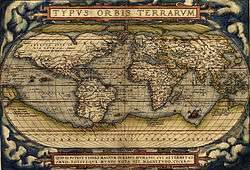
For many years, cartographers and European explorers speculated about the existence of the Terra Australis Incognita, a vast territory located in the south of the Strait of Magellan and Tierra del Fuego and reached the South Pole.
The Treaty of Tordesillas, signed on June 7, 1494, set the areas of influence of Spain and Portugal, west and east, respectively, of a line running from pole to pole that was never demarcated (at 46° 37 'W in the Spanish classical interpretation, and further west, according to the Portuguese interpretation), so the Antarctic areas claimed Chile today, still unknown at that time, fell within the area of Spain. The treaty, backed by the papal bull Ea quae pro bono pacis in 1506 that made mandatory for all Catholic countries, was not recognized by European non-Catholic states and even by some who they were, like France. For Britain, Dutch, Russia and other countries, the Antarctic areas were considered res nullius, no man's land subject to the occupation of any nation.
In 1534, The Emperor Charles V divided in three governorates the South American territory:
- New Castile or Peru to Francisco Pizarro,
- New Toledo or Chile to Diego de Almagro and
- New León or Magellanic Lands for Simón de Alcazaba y Sotomayor, which was subsequently extended to the Straits of Magellan.
In 1539, a new governorate was formed south of New León called Terra Australis to Pedro Sanchez de la Hoz. In 1554, the conqueror Pedro de Valdivia, who led the Governorate of Chile, he talked to the Council of the Indies to give the rights of New León and the Terra Australis to Jeronimo de Alderete, which, after the death of Valdivia the following year, became governor of Chile and annexed the Chilean colonial territory.
Proof of this are numerous historical documents, among which include a Royal Decree of 1554:
Because it was personally consulted, we will grant, to the Captain Jeronimo de Alderete the land across the Magellan Strait
Later, in 1558, the Royal Decree of Brussels it prompted the Chilean colonial government to take ownership in our name from the lands and provinces that fall in the demarcation of the Spanish crown in Referring to the land across the Strait, because at that time it was thought that Tierra del Fuego was an integral part of the Terra Australis.
One of the most important works of Spanish literature, the epic poem La Araucana by Alonso de Ercilla (1569), is also considered by Chile as favorable to their argument, as you can read in the seventh stanza of his Canto I:
Is Chile, North South, very long
New sea coast, of the south called
will from east to west, of wide
one hundred miles, so wider taken
under the Antarctic Pole height
Twenty-seven of prolonged degrees
until the Sea Ocean and Chilean
mix their waters within narrow
In the fourth stanza of his Canto III:
This was the one who found the sections
Indians of Antarctic regions
There are also stories and maps, both Chilean and Europeans, indicating the membership of the Terra Australis Antarctica as part of the Captaincy General of Chile.
The Spanish navigator Gabriel de Castilla sailed from Valparaiso in March 1603 in command of three ships in an expedition entrusted by his brother cousin viceroy of Peru, Luis de Velasco y Castilla, to repress the incursions of Dutch privateers in the Southern Seas, reaching 64 degrees south latitude. There have not founded in the Spanish archives documents confirming the reached latitude and sighted land; however, the story of the Dutch sailor Laurenz Claesz (is a testimony dateless, but probably after 1607), documents the latitude and time. Claesz said:
sailed under the Admiral don Gabriel of Castile with three ships along the coasts of Chile towards Valparaiso, and from there to the strait. In march of 1603 he reached 64 degrees and they had a lot of snow there. In the following April they returned back to the coast of Chile
Another Dutch document, published in Amsterdam in three languages in 1622, says that at 64°S there are "very high and mountainous, snow cover, like the country of Norway, all white, land It seemed to extend to the Solomon Islands" This confirms a previous sighting of the lands would be the South Shetland Islands.
Other historians attribute the first sighting of Antarctic land to the Dutch marine Dirk Gerritsz, which would have found the islands now known as South Shetland. According to his account, his ship was diverted from course by a storm after transposing the Strait of Magellan, in the journey of a Dutch expedition to the East Indies in 1599. There are doubts about the veracity of Gerritsz.
At this time was already known the existence of a white continent in south of the Drake Passage, separated from the Tierra del Fuego. In 1772, the British James Cook circumnavigated waters Southern Ocean.
19th century
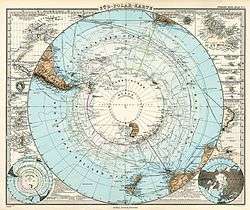
After the independence of the colonies in the Americas, the new republics were recognized each other the principle of uti possidetis, that is, new states would have as limits those inherited from the Spanish colonies which originated. Therefore, the Republic of Chile consisted of all lands formerly belonged to the Captaincy General of Chile and then assumed that these titles included rights over Antarctica.
In 1815, the Argentine-Irish Admiral William Brown launched a campaign to harass the Spanish fleet in the Pacific Ocean and, when implementing the Cape Horn, a strong Temporary him down to the Antarctic sea beyond the parallel 65°S on board Argentine vessels Hércules and Trinidad. Brown report indicating the presence of nearby ground.
On August 25, 1818, the Argentine government, then called the United Provinces of the Rio de la Plata, granted the first concessions for hunting earless seals and penguins territories for the Antarctic continent to Juan Pedro de Aguirre, who operated the ship Espíritu Santo doing based on the Deception Island, the largest of the South Shetland Islands.
The Ship Espíritu Santo was followed by the American brig Hercilia to Deception Island. The fact that these Argentine sealers were directed to the islands with fixed course usually regarded as proof that previously known.
Between 1819 and 1821, the Russian ships Vostok and Mirny under the command of the German Bellingshausen at the service of Russia, sailed the Antarctic seas. In 1821, at 69°W 53'S, he sighted an island which he called Land of Alexander I, after the Russian Tsar.
In 1819, William Smith rediscovered the South Shetland Islands, including the King George Island. In the same year it would have been spotted for the first time with certainty the Antarctic Peninsula by the American Nathaniel Palmer.
In 1821, John Davis would have landed on the Antarctic continent, although sealers remains found indicate that Americans have previously reached.
In 1823, the English James Weddell discovered the sea that now bears his name, reaching up to 74°W 15'S and 34° 17'W.
On June 10, 1829, the Government of Buenos Aires issued a decree creating the Political-Military Command of the Malvinas Islands and adjacent to Cape Horn in the Atlantic Ocean, an act that is usually considered as Argentina including the Antarctic islands.
From those years, the hunting of whales and sea Lions began to be increased in the zone.
In 1831, Chile's liberator Bernardo O'Higgins wrote to the Royal Navy talking about his country:
Old and new Chile extends, on the Pacific from the Mejillones Bay to New South Shetland, in latitude 65° South and on the Atlantic from San Jose Peninsula at latitude 42° to New South Shetland, that means, 23° with a glut of excellent ports on both oceans, and all of them wholesome in all seasons. A simple glance at the map of South America is sufficient to prove that Chile, as is described, holds the keys of that vast portion of the South Atlantic
In 1843, a Chilean expedition founded the Fort Bulnes, taking possession of the Strait of Magellan, just days before British and French ships arrived the same purpose.
In 1856, the treaty of friendship between Chile and Argentina that recognized boundaries was enacted uti possidetis juris, that is, those defined by the Spanish Empire until 1810.
The growth of the Chilean colony in Magallanes, and then in the city of Punta Arenas, allowed the founding of companies for hunting and exploitation of whales in Antarctic seas, which requested authorization from the government of Chile. In 1894, the power for the exploitation of marine resources in the south of the parallel 54°S was given to Punta Arenas Municipality.
20th century
In the early years of the 20th century, the interest of studying the Antarctic territories increased. Some of these expeditions asked permission from the government of Chile to be performed, among which one can highlight the Swedish teacher Otto Nordenskjöld in 1902 and the British teacher Robert F. Scott in 1900. Chile also gave mining permits, as conferred on December 31, 1902, Decree No. 3310 by Pedro Pablo Benavides to lease the Diego Ramírez Islands and San Ildefonso, may extend fishing south indefinitely on condition install a naval station in the islands.
On May 8, 1906, the Whaling Society of Magallanes was created with a base in Punta Arenas, which was authorized on December 1 to settle in the South Shetland Islands by Decree No. 1314 of the governor of Magallanes, which they did in Whalers Bay on Deception Island, there hoisted the Chilean flag and installing a coal deposit. That place was visited by Jean-Baptiste Charcot in December 1908 to replenish coal and continued to be inhabited in the summer season until 1914.
From 1906, they began to be promulgated several decrees, even from the National Congress of Chile, for mining permits in the Antarctic area. The Minister of Foreign Affairs of Chile mentioned on September 18, Chilean national day, of that year, the Chilean Antarctic rights in a memory and said that the delimitation of the territory would be subject to preliminary investigations. Argentina formally protested the June 10, 1907, for these actions in Chile and a negotiation process began for the mutual recognition of Antarctic territories. A limit was to be set to define two different areas, but this treaty was never signed.
On July 21, 1908, the United Kingdom officially announced its claim to sovereignty over all lands within the meridians 20° and 80° south of parallel 50°, in 1917 was moved to 58° south and in 1962, to the parallel 60° south.
In 1914, the British Ernest Shackleton began an expedition to cross the South Pole from the Weddell Sea to Ross Sea. With two ships, Endurance and Aurora, he went to Antarctica, but the weather worsened dramatically until an iceberg completely destroyed the first ship. Shackleton sailed to Argentine ports, the Falklands and South Georgia Islands without finding anyone who dared to be members of the expedition trapped in an Antarctic island. In Punta Arenas, however, he found the pilot Luis Pardo Villalón, who, aboard the Yelcho managed to rescue those shipwrecked on the Elephant Island. On September 4, 1916, they were received at the port of Punta Arenas as heroes. The Pilot Pardo feat, sailing with temperatures close to 22 °F (−30 °C) and a stormy sea of icebergs, made him win national and international recognition.
Sovereignty and Antarctic Treaty System
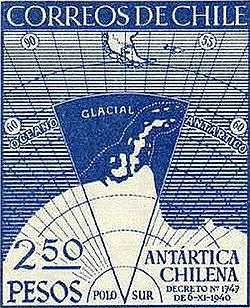
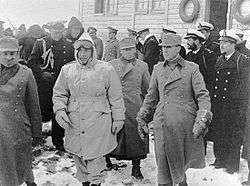
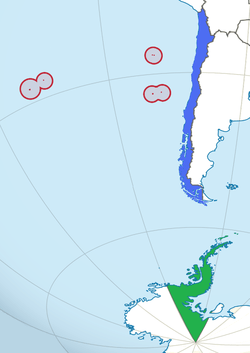
In blue: Continental Chile
In red: Insular Chile
In green: Antarctic Chile
On January 14, 1939, Norway declared its territorial claims on Antarctic territory between meridians 0° and 20° (Queen Maud Land), which alarmed the Chilean government, so the president Pedro Aguirre Cerda encouraged the definition of National Antarctic Territory and the September 7 of that year established by Decree No. 1541 a special commission to examine the country's interests in Antarctica.
The commission set the bounds according to the Theory of polar areas taking into account geographical, historical, legal and diplomatic precedents, which were formalized by Decree No. 1747, enacted on November 6, 1940, and published on June 21, 1955.[2] As in Chile is considered their Antarctic rights arrived until the line Treaty of Tordesillas, the decree setting the limit of his claim in a meridian located further west (the 53° West), his claim to not include the South Orkney Islands in consideration of the rights of Argentina.[3] Argentina formally protested by decree in a note November 12, 1940, rejecting its validity and expressing a potential claim to the same area. In turn, the United Kingdom objected to the February 25, 1941.
In the late 1940s, Argentina and Chile recognized each other "... that Chile and Argentina have unquestionable rights of sovereignty in the polar area called American Antarctica ("Antártida Americana" in Spanish)".
In January 1942, Argentina declared its Antarctic rights between the meridians 25° and 68° 24' W, that of Punta Dúngeness. On September 2, 1946, Decree No. 8944 set new boundaries for the Argentine Antarctic Sector between the meridians 25° and 74° west longitude. Finally, February 28, 1957, Decree Law No. 2129 established the definitive limits of their claim between the meridians 25° and 74° West and parallel 60° South latitude. This decree established a territory which is superimposed on part of the territory claimed by Chile.
Chile began to perform acts of sovereignty in the Antarctic continent with installation, Sovereignty Base current Arturo Prat in 1947. The following year, and as a way of settling the Chilean claims, the President Gabriel Gonzalez Videla opened the Base General Bernardo O'Higgins Riquelme, the first official visit of Head of state to Antarctica.
On 4 March 1948, Chile and Argentina they signed an agreement on mutual protection and legal defense of its Antarctic territorial rights, recognizing each other:
(...) until agreed, by mutual agreement, the line common neighborhood in Antarctic territories of Chile and Argentina, declared:
1) That both governments acting in agreement on legal protection and defense of their rights in American Antarctica, between the meridians 25° and 90° west longitude of Greenwich, indisputable sovereign rights are recognized by Chile and Argentina.
In 1953, the representative of India in United Nations presented a project for the internationalization of Antarctica, movement which adhered several countries without a history of acts of sovereignty over the Antarctic territory. That if they had started efforts to avoid internationalization, and Chilean ambassador in New Delhi, Miguel Serrano, persuaded the Prime Minister Jawaharlal Nehru down the proposal.
On May 4, 1955, the United Kingdom filed two lawsuits against Argentina and Chile, respectively, before the International Court of Justice for it to declare the invalidity of claims of sovereignty of the two countries on Antarctic and sub-Antarctic areas. On July 15, 1955, the Chilean government rejected the jurisdiction of the Court in that case and on August 1 so did the Argentine government, so the 16 March 1956 claims were filed.[4]
Law No. 11486 of June 17, 1955 added the Chilean Antarctic Territory to the Province of Magallanes, which became in July 12, 1974, the XII Region of Magallanes and Chilean Antarctica.
In 1958, the president of the US Dwight Eisenhower invited Chile to the Conference by the International Geophysical Year to resolve the issue Antarctic. On 1 December 1959, Chile signed the Antarctic Treaty, which stated that:
- Antarctica is World Heritage Site.
- Gives the Antarctic territory for peaceful purposes, prevented the military installation or navy.
- The signatory countries of the treaty with right establish base scientific purposes (marine biology, Seismology, volcanology, etc.).
- Freeze all the territorial claims, ensuring each signatory nation to a status quo for the duration of the treaty.
- In this territory for peaceful purposes can not be made nuclear tests, or war, nor leave toxic waste.
In July 2003, Chile and Argentina began installing a common shelter called Abrazo de Maipú, halfway between O'Higgins bases, Chile, and Esperanza, Argentina.
Geography and climate

The Chilean Antarctic Territory covers an area of 1 250 257,6 km², equivalent to more than 60% of total Chilean surface, which is covered in its entirety, except for small coastal areas, with a thick layer of ice and snow, which can exceed 1200 meters deep in some areas of the interior of the continent.
The Chilean claim is mainly constituted by a sector of the Lesser Antarctica or West Antarctica, which includes the Antarctic Peninsula, known in Chile as Land of O'Higgins, it is crossed longitudinally by the mountains of the Antartandes. This mountain range is the continuation of the Andes. The Antartandes in turn, clearly differentiate three geographic areas in the Land of O'Higgins: the western slope, the central plateau and the eastern slope.
Antartandes reach the 4190 meters of altitude in the Mount Jackson and 3655 meters in the Mount Coman.
Within the land claimed by Chile, in southwest of the territory are the highest summits of the Antarctic continent, including the point of highest elevation, which are part of the Sentinel Range:
- Vinson Massif of 4897 m
- Mount Tyree of 4852 m
- Mount Shinn of 4800 m
The claimed territory has a subglacial lake, the Lake CECs, which was discovered in January 2014 by scientists of Centro de Estudios Científicos headquartered in Valdivia, Chile, and was validated in May 2015 with the publication in the journal Geophysical Research Letters, which is a specialist in the topic. The lake has an estimated 18 km² area, is 2.6 km deep under the ice, is located in a buffer zone of three major glaciers so it is in a low-disturbance, and its ice motion is almost nonexistent. There is a hypothesis that it could have life, this would have developed in conditions of extreme isolation and the lake is encapsulated.
The precipitations in the territory are relatively rare and are decreasing towards the South Pole, where reigns the "polar desert".
Coastal areas more to the North, as the north of Antarctic Peninsula and the South Shetland Islands, have a subpolar climate or tundra, that is, the temperature average of the warmest month exceeds 32 °F (0 °C), some lands are permafrost. The rest of the territory is under the regime of Polar climate.
Population
The Antártica Commune has a population of 150 inhabitants on the Chilean bases, according to the census conducted nationwide in 2012, corresponding to 54 civilians and 96 military. These people are mostly members of the Chilean Air Force and their families, who live mostly in Villa Las Estrellas. This town, located next to the Base Presidente Eduardo Frei Montalva, on King George Island, was opened on April 9, 1984, and has an airport, a bank, a school and child care, a hospital, a supermarket, mobile telephony and television.
In 1984 the first Antarctic Chilean, Juan Pablo Camacho Martino, was born in Villa Las Estrellas. So far, a total of three people have been born in the Chilean Bases. At present, the development of tourism has increased explosively through airplanes and cruise ships that depart from Punta Arenas or Ushuaia.
Bases, stations and settlements
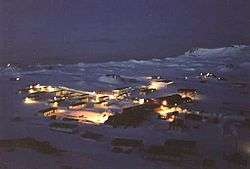
Due to the geographical characteristics of the Antarctic Peninsula, it has the best conditions for the development of human life. That is why in the Chilean Antarctic Territory is the largest number of international bases.
There are four Chilean permanent bases operating through the year, while there are other four that remain open only during the summer (December - March) (Seasonal) with three shelters.
The largest population center is located in King George Island and is formed by the Base Presidente Eduardo Frei Montalva (1980), which has an airstrip, the Meteorological Center President Frei (1969) and the Villa Las Estrellas. Belonging to Chile, this enclave is the nucleus of more important logistical support to the remaining countries with scientific bases on King George Island.
The Chilean Antarctic Institute (INACH) under the Ministry of Foreign Affairs, opened on the same island Base Professor Julio Escudero, chief scientific center of Chile in Antarctica.
The Chilean Navy also assists in the Mendel Polar Station belonging to Czech Republic from the January 14, 1995. The maximum is four Chilean researchers to carry out scientific work at the base. To realize this possibility, Chilean researchers must submit a letter from a leading Czech researcher, who collaborate in its proposal List of Chilean Antarctic Bases:
(P): Permanent; Are open all the year. (S): Seasonal; Are open in the Austral Summer. The largest population center is located on King George Island and consists of Frei Montalva Station, which has an airport (Teniente Rodolfo Marsh Martin Aerodrome, ICAO Code SCRM [5]), and which is connected to the communal capital, the village of Villa Las Estrellas, which has a town hall, hotel, day-care center, school, scientific equipment, hospital, post office and bank. This enclave is a center of logistical support for the other eight countries with scientific bases on King George Island.
Nearby Professor Julio Escudero Base, controlled by the Chilean Antarctic Institute (INACH), under the Ministry of Foreign Relations, is the main Chilean scientific facility in Antarctica.
Captain Arturo Prat Base is a Chilean Antarctic research base located on Greenwich Island. Opened February 6, 1947, it is the oldest Chilean Antarctic base. Until March 1, 2006, it was a base of the Chilean Navy, on which date it was handed over to the regional government of Magallanes y la Antártica Chilena Region. Until February, 2004, it had been a permanent base. Afterwards, it had served as a summer base of ionospheric and meteorologic research. the base reopened in March 2008 for permanent occupation.
The only permanent Chilean base on the Antarctic mainland (Antarctic Peninsula), Base General Bernardo O'Higgins Riquelme has been in operation since February 18, 1948. It is located on Puerto Covadonga and it is the official communal capital.
Seasonal bases
- Estación Polar Científica Conjunta "Glaciar Unión" 79°46′10″S 82°54′26″W / 79.76944°S 82.90722°W; (Scientific Polar Station Joint "Union Glacier" in English ) Teniente Arturo Parodi Alister Base and Antonio Huneeus Antarctic Bases Moved to the new location, it is ubicated in the Ellsworth Mountains, Union Glacier. The company Antarctic Logistics & Expeditions LLC is operating the airport in the Union Glacier since 2008.
- Dr. Guillermo Mann Base 62°28′2″S 60°46′3″W / 62.46722°S 60.76750°W; summer base of the Chilean Antarctic Institute (INACH), under the Ministry of Foreign Relations, in Livinsgton Island. Weather and ecological research station. Archaeological research site about former sealers. Another former Chilean refuge also called "Dr. Guillermo Mann" (or Spring-INACH), located in P. Spring (Pen. Palmer), is in ruins.[6]
- Luis Risopatrón Base (formerly "Copper Mine Naval Refuge") 62°22′17″S 59°42′53″W / 62.37139°S 59.71472°W; summer station of the Chilean Navy in Robert Island. Geodetic, geophysical and biological research station.
- Julio Ripamondi Base 62°12′37″S 58°56′7″W / 62.21028°S 58.93528°W; little summer station of the Chilean Antarctic Institute (INACH), located in Ardley Island, next to Frei Montalva Station and Professor Julio Escudero Base (nearby located in the King George Island). The Ripamondi Base conducts research on geodesy and cartography (since 1997), terrestrial biology (since 1988) and studies of penguins (since 1988). The base is located near a large colony of gentoo penguins.
- González Videla Base 64°49′26″S 62°51′27″W / 64.82389°S 62.85750°W; station of the Chilean Air Force on the Antarctic mainland's Waterboat Point in Paradise Bay. It is now an "inactive" base, it started to be repaired since 2003, with fuel and supplies in storage in the buildings for emergency use, or in case the base were to be reactivated in the future. Occasional summer visits are made by Chilean scientists and tourists. The base was recently used (2011) in researches of the Chilean Antarctic Institute (INACH)
- Yelcho Base 64°52′33″S 63°35′02″W / 64.87583°S 63.58389°W (ex Sub Base Yelcho) is ubicated in the south bay of Doumer Island, Palmer archipelago, was reopened in March 2015.
Gallery
-
Pedro Aguirre Cerda Base (Closed Today), in Deception Island, 1958.
-
Chilean patrol Lientur in Cooper Mine, Robert Island, 1958.
-

Panoramic view of Villa Las Estrellas in winter.
-
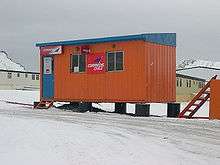
Correos de Chile office in Antarctica.
Notes
It corresponds to 62.28% of the national territory total, if the Chilean Antarctic Territory is included.
See also
- (Spanish) Territorio Chileno Antártico
- Antarctic Treaty System
- List of Antarctic territorial claims
- Antártica Chilena Province
- Antártica (Commune)
- Magallanes and Antártica Chilena Region
- Argentine Antarctica
- Australian Antarctic Territory
- Ross Dependency
- Marie Byrd Land
- British Antarctic Territory
- Tierra del Fuego Province, Chile
- Tierra del Fuego Province, Argentina
- Beagle Channel Arbitration
- Falkland Islands
- Villa Las Estrellas
- Peter I Island
- Queen Maud Land
References
- 1 2 3 "Censo 2012 - POBLACIÓN TOTAL CONTABILIZADA, CENSADA Y ESTIMADA DE MORADORES AUSENTES, POR SEXO E ÍNDICE DE MASCULINIDAD, SEGÚN REGIÓN, PROVINCIA, COMUNA Y ÁREA URBANA - RURAL. (POBLACIÓN INCLUYENDO ESTIMACIÓN DE MORADORES AUSENTES)" (in Spanish). National Statistics Institute. Archived from the original (xls) on 6 March 2014. Retrieved 12 March 2014.
- 1 2 Ministry of Foreign Affairs (Chile) (1955-06-21). "Fija Territorio Chileno Antártico" (in Spanish): LeyChile. Retrieved 1 May 2015.
- ↑ Note: some Chilean nationalist sources say that Chile resigned of a third of its Antarctic sector in favor of Argentina, without explaining where to take the data, which the Tordesillas line passing through the meridian 37° 7'West however, classically it considered that Spain stood at 46° 37 'West.
- ↑ International Court of Justice (May 4, 1955). "Contentious Cases: Antarctica (United Kingdom v. Argentina)". Retrieved March 21, 2011.
- ↑ Swartz, Karl. "SCRM - Teniente Rodolfo Marsh Martin, King George Island, AQ - Airport". Great Circle Mapper. Retrieved 4 June 2015.
- ↑ Paul Jeffrey. Cristian Donoso and Claudio Scaletta completes historic journey in Antarctica
External links
| Wikimedia Commons has media related to Antártica Chilena. |
- (Spanish) Gobierno Regional Magallanes y Antártica Chilena Official website
- (Spanish) Gobernación Provincia de Antártica Chilena Official website
- (Spanish) Chilean Antarctic Institute Official website
- (Spanish) Chilean Sea Document
- (Spanish) Municipality of Cape Horn


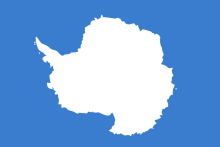

.svg.png)